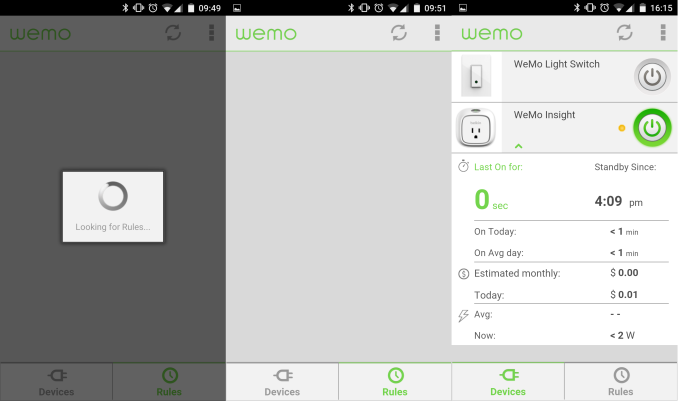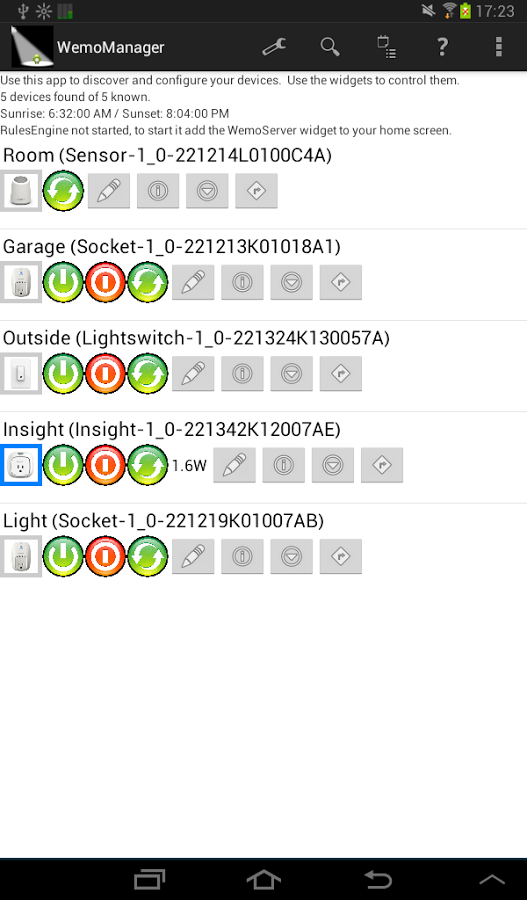Belkin WeMo and Ubiquiti mFi Home Automation Platforms Review
by Ganesh T S on April 27, 2015 8:00 AM EST- Posted in
- Home Automation
- Belkin
- Ubiquiti Networks
- IoT
WeMo Setup and Usage
The WeMo Insight Switch is easy to get up and running, as it just needs to be connected to a power outlet, but the Light Switch is a complicated install due to its in-wall nature. The process is similar to that of the mFi Light Switch & Dimmer. Depending on local regulations, one might need a licensed electrician for the installation. It is important to remember that both these in-wall devices need a neutral wire. Belkin provides a YouTube video with instructions for a DIY install. Just like the mFi InWall light switch, it is good to ensure that there is enough depth and space available in the wall opening to safely install the unit.
The Insight Switch can be controlled directly, thanks to a capacitive on/off touch button on the top. Also, unlike the non-monitoring version, it doesn't block the adjacent port.
WeMo units are setup in a manner similar to the mFi - However, unlike the mFi units where any computing platform with a web browser can be connected to the ad-hoc Wi-Fi network, only smart devices running the WeMo app can be used to setup the units. Belkin's market is for simple setup and operation for unsophisticated users. There are no IP addresses for the users to find or configure, no local web pages, no router changes, no usernames and passwords etc. The authentication is purely via Wi-Fi SSID. The units communicate with Belkin's cloud servers to enable access over the Internet.
The official usage model is through smart devices. The mobile apps allow control and also setting up of rules and scenes. Users can also edit the WeMo devices (names, icons etc.), connect them to IFTTT and export generated data via e-mail / schedule the export (the last point is applicable only to WeMo Insight).
Unfortunately, the WeMo app (the Android version, at least) has been inconsistent over the last year or so. Earlier, I used to be able to set up rules and modify them, but, recently, the app never loads the rules and doesn't allow adding them either. In addition, the energy monitoring aspect of the Insight has become flaky - reading the unit as being on standby even when a load is connected to it.
The division of work between the cloud infrastructure and the local device is not well-documented. We know that WeMo's official APIs communicate via their cloud servers. However, most specific rules (that deal only with that particular device) such as schedules can work independent of the cloud.
MPP App Suite - WemoManager and WemoServer
WeMo, being one of the pioneers in the mass-market home automation ecosystem, piqued the interest of hackers with good intentions. Multiple efforts have gone into deciphering the control protocol and putting it to use in unofficial third-party scripts and applications.
The most comprehensive reverse-engineering / consumer-friendly attempt is Mike's WemoManager / WemoServer. Part of the MPP App Suite, readers must note that the app is not free. The WemoServer does have a free standalone implementation, but requires the WemoManager paid app for extra functionality such as remote access. Mike does deserve recognition for what he has achieved, but, this should have been Belkin's strategy with the WeMo from the beginning (note that Ubiquiti Networks is doing the same thing with the mFi - providing the rules and scenes backend for all devices as a free download that can operate independent of the cloud).
Mike shares many of our thoughts - particularly the aspect that the cloud is probably not the best place to run home automation. It's too slow, occasionally unreliable, and certainly a security risk. As mentioned earlier, Belkin's cloud approach is perfect for unsophisticated users. However, this doesn't mean that power users need to be left out.
Another aspect that we dealt with in our home automation consumer checklist earlier this month was the monetization potential of the cloud. It is likely that Belkin will move to do that in the future - after all, someone needs to pay to keep the cloud servers running and there are no subscription aspects attached to the WeMo devices right now.



















41 Comments
View All Comments
Lezmaka - Monday, April 27, 2015 - link
Belkin is charging $50 for the light switch and $60 for the outlet switch ($8.49 and $5 cheaper on amazon)? At prices like that the only way I can see myself buying one is if there's something I really really need to be able control remotely.V900 - Monday, April 27, 2015 - link
What exactly, is the usage scenario of a remote controlled outlet?!?Yeah, you can measure how much power is used, something thats easily done with a regular outlet, but besides that?!?
Considering that you could just get a "smart" remote controlled appliance, and plug it into a regular outlet, this just screams solution in search of a problem.
beginner99 - Monday, April 27, 2015 - link
Yeah. Don't see that either. For me I see potential in the light-switch and motion sensor. Turn-on light when entering room, turn off when leaving. But then I doubt this will work that way and reliably especially if more than 1 person is involved. So the sensor would need to track how many people are in the room. It's unclear if this is possible.The Wemo Switch may work as well if you have a floor lamp plugged into an standard outlet (not controlled by the rooms light switch).
Daniel Egger - Monday, April 27, 2015 - link
> Turn-on light when entering room, turn off when leaving. But then I doubt this will work that way and reliably especially if more than 1 person is involved.Why wouldn't it? But that still gets annoying very quickly for areas where you spend lots of time in and it doesn't combine well with dimming which is more of a feature you'd want to have in a living area.
V900 - Monday, April 27, 2015 - link
Has anyone, anywhere the past 100 years ever reached a level of laziness so monumental, that pressing a switch right by the door, becomes a task so arduous and troublesome that it's best left to technology?Personally I prefer natural light, and don't turn on the lights until it's necessary. I doubt I'm the only one, so now your light switch also has to monitor light levels, and whether it's cloudy.
Unless of course I just got up, in which case, full on lights right as I enter a room is the last thing I want. So a rules based system would also have to have rule for this.
Idk. I hate to be a Luddite, but I suspect that for most people the trouble and effort they'd have to
put into it far surpasses the benefits.
Hyper72 - Monday, April 27, 2015 - link
I would tend to agree, though for myself I'm not most people; A broken neck puts me in a group of users most pleased with WeMo light switches I can control from my phone, just as I control my thermostats.beginner99 - Tuesday, April 28, 2015 - link
I agree mostly but there are cases where it helps like the floor lamp plugged into a socket not linked to the light switch. Or at my GF place the light switch if you enter the apartment is not next to the door but on the opposite wall to the left about 6 feet from the door. So you have to kind of fiddle around in the dark to put on the light or when leaving first open door, then walk back to turn light off or else your completely in the dark. Here a motion sensor would be great help.jeffkibuule - Monday, April 27, 2015 - link
You should create simpler rules than that. Light on around sunset, light off whenever you usually go to bed (12am-ish for me). And even if you aren't there, it acts as a super cheap theft deterrent.Daniel Egger - Monday, April 27, 2015 - link
lol, right...cbgoding - Monday, April 27, 2015 - link
I use one to remotely reboot my slingbox, which for whatever reason locks up every month or two.